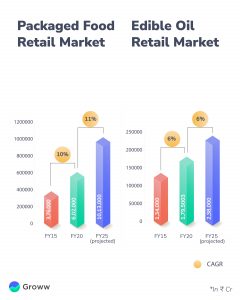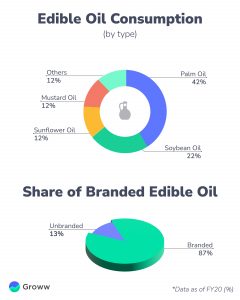Where does Adani Wilmar’s growth come from?
Adani Wilmar has strong brand recognition in the domestic market and has a leading position in most of its products.
While the demand for products like wheat, rice, flour, and edible oil is constant, there are a few key triggers that helps in the growth of the companies operating in these segments in the coming years.
Preference toward packaged products:
There is a growing preference among consumers for packaged food instead of loose and unbranded products. This segment is likely to grow at the rate of 14% in the coming years as per industry reports. Health concerns and quality standards have accelerated this adoption.
For Adani Wilmar, this market condition bodes well. It has a dominant market position when it comes to edible oil. It comes in handy for expanding in new and value-added packaged foods.
- There is growth potential in RTE (ready-to-eat) and RTD (ready-to-drink) products and certain kitchen essentials like flours, rice, pulses and atta. And the company has plans to expand in this space as well.
- While the FMCG space is already competitive with players like HUL, there is still space for growth. This is because the market space for most kitchen essentials like atta or pulses is highly fragmented with regional and local players. For instance, AWL (through Fortune brand) has entered the atta market. For the year FY22, the company has launched Poha and Khichdi under RTE.
Increasing edible oil consumption:
Oil, like water, is one of the essential parts of everyday life. Considering the changing preferences of tastes of consumers, new and innovative eateries entering the market are driving the growth of all kinds of edible oil in India. And the largest oil consumer is food processing units like hotels. This is good for oil makers like AWL.
Brand
While the branded edible oil market is competitive, AWL’s brand of Fortune is among the leading players in the industry. There are four key edible oils that contribute about 85% of revenue for most players and the industry. These are palm, soy, mustard, and sunflower oils.


